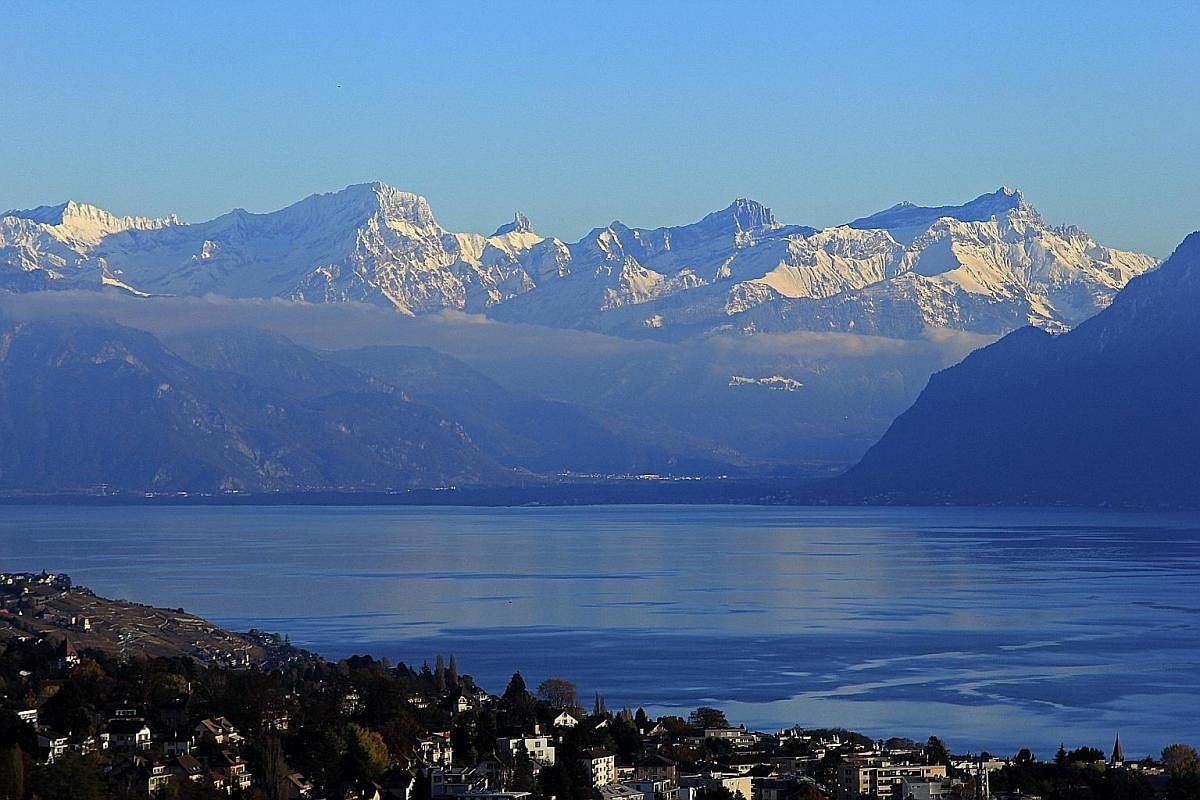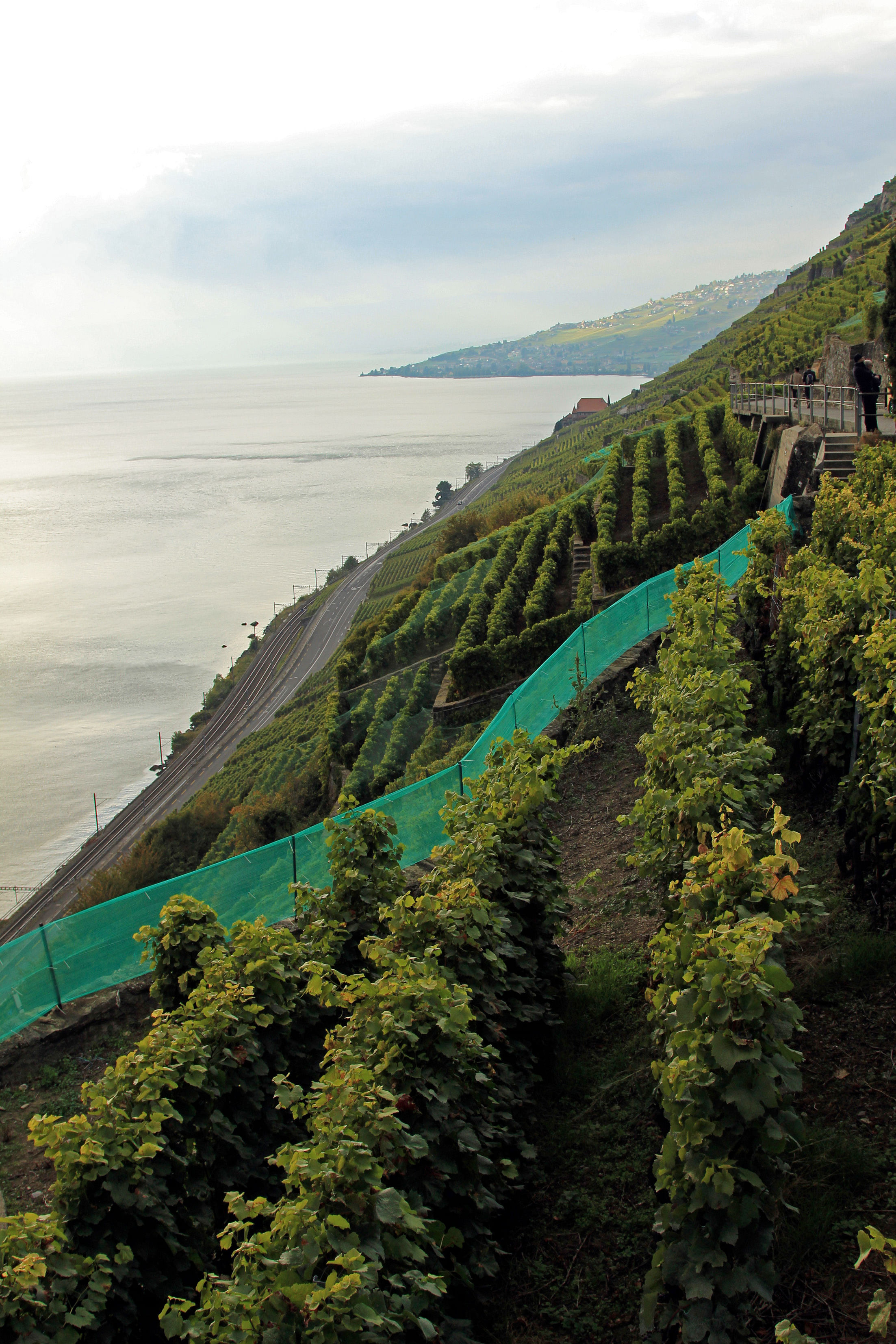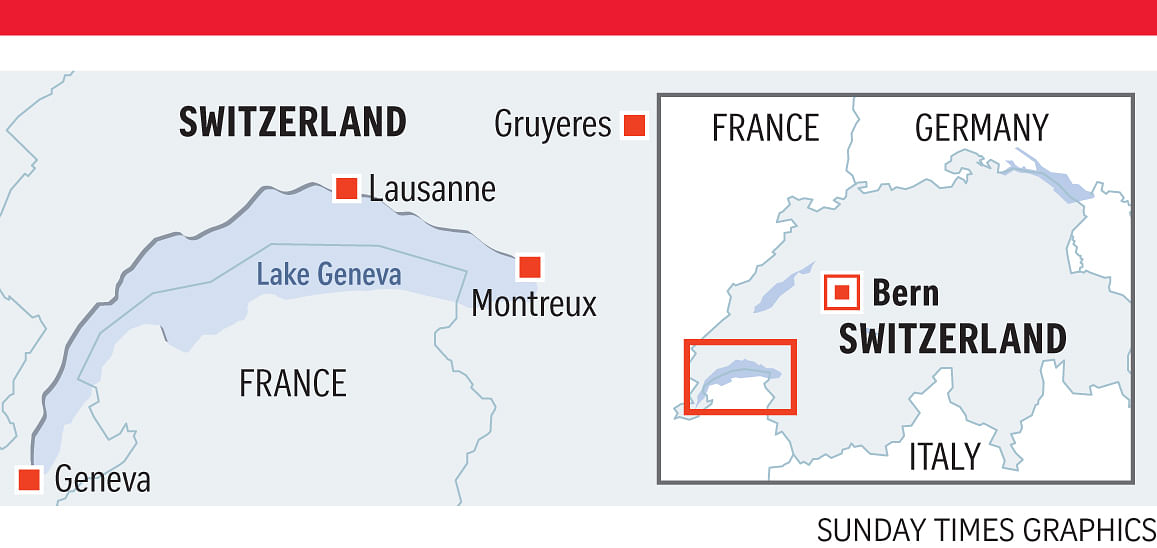-
Getting there
Swiss Air (www.swissair.com) and Singapore Airlines (www.singaporeair.com) fly daily from Singapore to Geneva via Zurich, while Qatar Airways (www.qatarairways.com) flies via Doha.
There are also daily direct trains from and to Zurich, Paris and Milan. Tourists can buy the Swiss Travel Pass starting at 216 Swiss francs (S$303) online at www.sbb.ch. The pass provides all-inclusive nationwide travel by rail, bus and ferry, plus access to museums and other activities.
There are a number of car rental companies located at Geneva International Airport, which is less than 10km from the city centre. It is best to book in advance. If entering by car from France, Italy or Germany, you will need to pay a highway tax (40 Swiss francs).
Travel tips
• Geneva and the Suisse-Romande regions receive favourable weather all year round. The best time to explore vineyards is between May and October. Ideal ski conditions are normally from January to early March. During summer, the average temperature at the lake is 30 deg C. Swimming and boating in the lake are popular pastimes for the Swiss.
• The euro is accepted throughout Switzerland, while ATMs give the option to choose Swiss francs or euros. Some businesses will provide change only in Swiss francs.
• If cheese is not your thing, the alternative is the Chocolate Train, which runs from Montreux to the exclusive Cailler Chocolate Factory in Broc, between spring and autumn. Go to www.goldenpass.ch/en/ for the schedule.
• For more tourist information and events, go to www.myswitzerland.com/en-ch/home.html
Geneva: Gateway to foodie haven
Geneva, famous for Western Europe's biggest lake, makes for a culinary adventure and a portal to the country's beauty and history

"Boring" is a word I hear a lot when discussing Geneva. Like Zurich in the north, this Swiss city has been accused of being an expensive place of business, diplomacy and banking - and not much else.
Having just moved to Switzerland with my partner, I am curious to see if this reputation is deserved. So we decide to dive into this historic lakeside region.
Known locally as Lac Leman, Lake Geneva is the biggest body of water in Western Europe. Covering an area of 580 sq km, this lake, gently ebbing against the snow- capped Alps, is a sight to behold any time of the year.
Moored in a valley at the southwestern tip of the lake, where it empties into the River Rhone, is Geneva.
Founded in the 14th century, the city is an intriguing mash-up of old and new, cobblestone streets and bustling tramways, some of which go directly into neighbouring France.

Wanting to maximise our lakeside weekend, we stay at the Hotel d'Angleterre (www.dangleterrehotel.com), one of the few boutique hotels skirting the lake.
This lavish five-star property, built in 1872, is considered a heritage site. Each of the 30 rooms is designed on a different theme by the owners, the Tollman family, who are behind a global hospitality empire that includes Contiki and Insight Vacations.
Our first-floor room is best described as Le Grande Chocolat. It is an opulent suite with a lake-facing balcony and lounge area decked out in rich earthy browns and gold trim.
There is a knock on the door and we are greeted with two glasses of Ruinart champagne. This is already shaping up to be quite the deluxe lake experience.
Flutes in hand, we step out to the balcony. Before us is Geneva's Jet d'Eau. This magnificent water fountain has been a fixture in Geneva since 1891, pumping out 500 litres of water a second at a rate of 200km an hour, 140m into the air. It creates an unexpected shower if a strong breeze picks up.

Beyond the Jet lies the quaint old town, akin to a little pocket of Paris, lined with trees and shuttered windows.
In the distance, the silhouette of Mont Blanc looms above the horizon. It is high time for us to indulge in the hotel's much-celebrated Champagne High Tea (47/59 Swiss francs or S$66/83), served daily between 3 and 6pm.
As the champagne pours, sunbeams dart through the bubbles and gold stars dance across the white linen of the table, a stone's throw from the lake. Tres idyllic.
Nine immaculately presented dishes arrive in quick succession, a moreish mixture of classic British with a lick or two of French culinary styling. The standouts: flavour- packed chicken and mayonnaise Swiss rolls with chopped almonds; orange cake with dark chocolate ganache; and buttery-perfect scones with a dollop of oh-so-Swiss double creme du Gruyeres.
One of Switzerland's most surprising secrets is its local wine. Geneva and its neighbouring canton of Vaud produce some of the most highly regarded vines.

In Geneva alone, there are more than 100 vineyards producing primarily Pinot Noir, Gamay (a blend of Pinot and Gouais Blanc) and indigenous Chasselas, a medium-bodied, dry white wine with hints of white flowers, citrus and bitter almond.
As we are hard-pressed for time to visit the cellar doors, we decide instead to go aquatic for a tipple of Geneva's best. Barkavin (www.geneve.com) is part of a series of wine events held throughout the year in the city, showcasing Swiss wine on board a classic paddle steamer, many of which ply the lake daily. For 15 Swiss francs, you get to meet the local vintners and sample dozens of wines.
Always up for anything sparkling, we are soon drawn to the wines of Domaine de la Vigne Blanche (www.lavigneblanche.ch/en). Winemaker Adeline Costa produces a traditional method sparkling brut, known as cremant.
However, what is different is that this off-dry wine is made from pinot blanc and aligote, the smaller, alpine cousin of chardonnay. This delicate, well-balanced sparkling has pronounced notes of white stone fruit, mountain flowers, biscuit and marzipan. Intriguing and unexpected.
By the end of the evening, we have tasted more than 20 wines and, with a couple of boxes in hand, we make our leisurely way back to the hotel.
As we cross the main bridge at Pont du Mont-Blanc, the expanse of Lake Geneva envelopes us, its end now infinite, blotted out by low- hanging fog. Somewhere beyond awaits tomorrow's excursion.
The next day starts early with some all-inclusive champagne over breakfast. I have planned a day in the nearby mountains of Fribourg, where more gourmand escapades are said to exist.
The rail line hugs the lakeshore as we travel west through Vaud. The lake is like a mill pond, a handful of yachts cut noiselessly through the azure water. Just out of the village city of Lausanne, we spot the undulating terraces of Lavaux (www.lavaux.com), home to some of Europe's oldest grape vines and a Unesco World Heritage Site.
Peppered across this more than 20km stretch of vines are small cellar doors where you can buy direct from the winemaker. There are also a number of easy hikes that traverse the many terraces.
We make a brief stop at Montreux and transfer to Le Train du Fromage (www.goldenpass.ch/en), a panoramic rail service that travels on Fridays and weekends from December to April. Aptly, we are served local wine and cheese as we make the steep ascent above Montreux and into the region of Gruyeres.
Our train stops at the blink- and-you-will-miss-it snow-covered village of Chateau-d'Oex.
After a short stroll with the rest of our cheese-loving party, we arrive at Restaurant Le Chalet for lunch. We can also make cheese here.
We get a prime seat near the cheesemonger - dressed in traditional Swiss lederhosen - as he prepares the demonstration. He pours around 200 litres of fresh milk into a large copper cauldron and swings it across the fire.
"Qui veut aider?" he asks (meaning, "who wants to help?") and I eagerly jump up and join him, stirring the milk in a constant figure of eight with a large wooden paddle till it reaches an exact 32 deg C. We then add rennet to help start the fermentation process.
While the cauldron simmers, our waitress prepares the moitie- moitie (half-half) fondue of organic Chalet and l'Etivaz cheeses. Like New Zealand and Australia with pavlova, there is an ongoing battle between France and Switzerland as to who can claim origin rights to this simple meal of melted alpine cheese, mixed with white wine, Kirsch, flour, garlic and pepper, served with bread.
As we begin dipping in, our waitress cheekily cautions us that if we lose a piece of bread from our fork, we'd need to forfeit an item of clothing. I pity diners with a penchant for losing things in this weather. We tactfully keep every piece of bread under our control.
Alongside, we enjoy a bottle of crisp, fruity Lavaux Chasselas (21 Swiss francs). The high acidity balances out the rich fondue. A match made in mountain heaven.
As we mop up the last of our fondue, the cheesemaker scoops up the ochre-coloured cheese granules in a muslin cloth. The load, weighing around 10kg, is then swiftly transferred to a mould and pressed before ageing. In five months, this round of cheese will form part of someone's fondue lunch.
With the fragrant, nutty aroma of cheese still wafting about us, we decide on a slight detour on our way back to Geneva.
Poised on the top of a rocky hill, the mediaeval village of Gruyeres is the saintly home of this world- renowned white cheese. The German-esque village, complete with a castle, contains a number of buildings dating back more than 400 years. It is like we have stepped into a Grimm's fairy tale.
Entering the castle courtyard, the last thing you would expect to find is an extra-terrestrial xenomorph, but this little village is the location of the H.R. Giger's Alien Bar and Museum (www.hrgiger.com/barmuseum). It was opened in homage to the late Swiss-German artist who designed the horrific acid-spitting alien from the 1979 space horror movie.
We make our way inside. In an instant, we are in the belly of the beast. A cavernous skeletal roof arches above us and, along the twisted bar, revellers are enjoying ornately coloured cocktails while sitting in bone-latticed thrones.
The tinted windows are framed with insect-like tendrils and, above a large communal table, a bulbous slug-shaped sculpture dangles. Enchanting and horrifying all at once.
We get ourselves an alien table for two and peruse the list of signature cocktails ranging between 7 and 13 Swiss francs. We both decide on the aptly named Dark Shadow. The potent blood-like mix of black vodka, cola and green lemon definitely leaves a lasting impression.
Other choices include Face Hugger (red vodka and Bailey's) and the Giger Mojito made with prosecco. A movie lover's bucket-list moment.
Very full and contented, we are lulled into an alien-infused cheesy sleep by the gentle rock and rhythm of the journey back.
In our suite of chocolate decadence, we run a bath and throw open the balcony doors. It is a cool night, but not too cold. The Jet is washing the old town in electric blue light.
Our Swiss-gourmand adventure at Lake Geneva is all too soon coming to a close. We had time only to dip our toes in the lake, but already, we know the naysayers' claims of "not much to do" are unfounded.
This lake-centric region is best described as Europe: bite-sized. And it is the gateway to some of the most beautiful, historic and tasty parts of this landlocked mountainous country.
I can't wait for summer harvest now.
• Marc Checkley, formerly a Straits Times copy editor, is a New Zealand freelance writer and producer working in the United Kingdom and Switzerland.
Join ST's Telegram channel and get the latest breaking news delivered to you.
A version of this article appeared in the print edition of The Sunday Times on April 30, 2017, with the headline Geneva: Gateway to foodie haven. Subscribe

